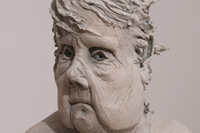When you walk into the Andrews Gallery, you are greeted immediately by life-size sculptures, small figurines, busts that appear to be crawling across the floor and a collection of sculptures mounted on the wall. All of these objects are part of the gallery’s current exhibition, which is made up of work by artist Andrea Keys Connell, an award-winning artist and professor of art at Virginia Commonwealth University. Last Thursday, students at the College of William and Mary and community members gathered in the Andrews lecture hall to hear Connell speak and attend a reception.
Connell’s exhibition contains sculptures from several different installations, inspired by myths, nursery rhymes, history and archetypes. One set of installations, a figure leaning on a cardboard box and bust planted in the floor, is entitled “…Gently Down the Steam…” and is based on the children’s song “Row, Row, Row Your Boat.” The lyrics, “life is but a dream” resonated with Connell in a philosophical way.
“What a deep, poetic and dark song to sing to a child,” she said.
Another installation incorporates an entire wall and the floor and is based on the twelve labors of Hercules. Seeking absolution for the death of his family, the titular character from the myth had to complete these tasks; however, Connell’s representation shows Hercules being chased by his labors rather than fighting them.
“The Hercules installation deconstructs the myth of this heroic character, and it challenges the viewer’s conceptions of masculine-heroic archetypes,” Connell said.
Elaine Vega ‘13, who attended the exhibit, was impressed with this particular installation.
‘The [Hercules] sculptures at the end of the wall attracted my attention as soon as I stepped into the main room,” Vega said. “Each individual piece strongly invades the surrounding space and creates distinct impressions.”
Connell explained that the inspiration for her work comes from multiple sources.
“I’m a maker in my heart and in my hands, and I feel a great sense of responsibility for what I make,” she said.
One of the guiding themes behind the sculptures is trauma, which Connell also notes as a source of inspiration.
“The issues that are important to me always refer to the individual conscious and how an individual can be the most whole. … I understand that to be the most whole, you have to look at the most fragmented parts of yourself,” she said.
Connell is also influenced by the family unit, which she described as one of the many fragments that combine to form an individual. In her sculptures, she often explores intergenerational trauma and the human condition.
Some examples of the influence of intergenerational trauma in Connell’s exhibition are the Hummel figurines.
“The Hummel figurines began as sweet drawings of children made by a nun, and they were put into production by a German Porcelain factory in 1935, which was also the year that Nazi Germany passed the [anti-Semitic] Nuremberg Laws,” she said. “When the war began production of the pastoral, innocent, porcelain figures ceased but restarted when it ended. However, the figurines were being sold as souvenirs to American G.I.s who sent them to their families in the U.S.”
Connell, whose grandmother was a Holocaust survivor, began dismantling the propagandist archetype by portraying the Hummel as an actual child who had not been able to deal with the trauma of the experience.
“They’re dislocated,” she said. “Existing both in and outside of time and in a non-space.”
Connell’s sculptures occasionally involve common objects as pedestals, like a moving box or a file cabinet.
“I always play with the pedestal.…I want them to exist in our world but not of our world, so the pedestals become their potential home,” she said.
Along with employing unexpected objects in her artwork, Connell also uses clay in her sculptures, although it is predominantly used in ceramics.
“I enjoy pushing the boundaries of expectations,” she said. “[Clay] is a crafting medium which makes it exciting to be used in sculpture. It also provokes an interesting conversation about where [the sculptures] belong in the scheme of art.”
Connell described her sculptures as vessels, and explained her personal process for constructing them.
“All of the sculptures are made hollow and I push against the inside of them to intimately construct the figure,” she said.
Naomi Falk, a College art professor, said that she is impressed by the unusual nature of Connell’s work.
“I like that she’s using clay as medium, building over life-size figures, and that she doesn’t glaze them [is] a little different,” she said. “She paints them to look like malleable unfired clay. It’s a curious play with materials.”
At the event, the students and faculty present had the opportunity to approach Connell with their questions. She explained her hope that those who view her sculptures will not only admire them, but will take some time to reflect on themselves as well.
“[My work is] a natural curiosity of people, and an attempt at understanding why they are the way that they are,” she said.

